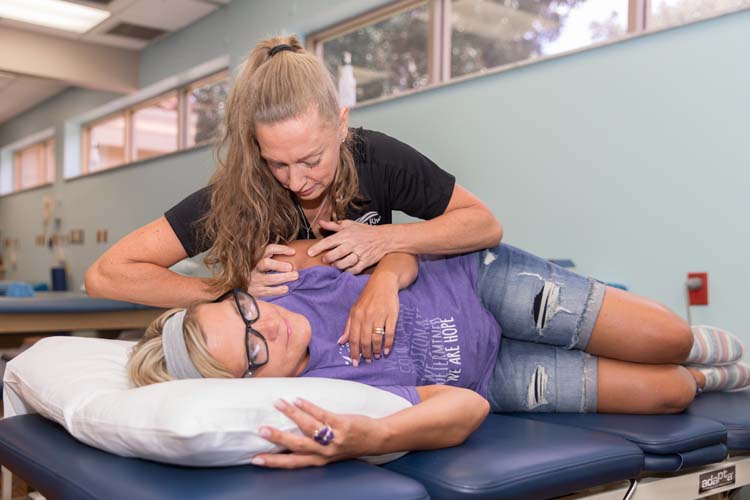
[ngg_images source=”galleries” container_ids=”7″ display_type=”photocrati-nextgen_basic_imagebrowser” ajax_pagination=”0″ order_by=”sortorder” order_direction=”ASC” returns=”included” maximum_entity_count=”500″]People undergoing treatment for breast cancer, prostate cancer, lymphoma, melanoma and, indeed, a host of other cancers are prime candidates for a new application of a very old form of therapy.
Massage.
“Oncology massage can support quality of life before, during and at the conclusion of rigorous cancer treatments,” according to the Sidney Kimmel Comprehensive Cancer Center at Johns Hopkins University. “Massage can also ease residual symptoms after treatment. Whether fighting to get well or working to stay well, oncology massage is a safe and supportive therapy for cancer and the treatment of its side effects.”
At the Indian River Medical Center’s rehabilitation therapy center, Dr. Patrick Judson from the adjacent Scully-Welsh cancer center, along with therapy specialists Marieke Dam and Susan Emerson and local cancer-survivor Nicole Lewis, all echo the claims of the famed Baltimore medical center.
In fact, they collectively say that massage therapy really ought to start sooner in the cancer-fighting process than it has in the past and sometimes still does today.
Lewis speaks from personal experience.
Her battle with breast cancer began in 2005 when, she says, “I never had physical therapy after my mastectomy,” and today, a dozen years later, she has severely limited range of motion in her left arm and shoulder.
One likely culprit? Radiation-induced fibrosis.
The American Association for the Advancement of Science explains that fibrosis is a process of scarring caused by radiation treatments in which healthy, flexible tissue, ligaments and muscles are replaced by far less elastic connective tissue, which “leads to hardening and functional impairments.”
And pain.
The U.S. National Library of Medicine agrees. No matter how “pinpoint” any radiation therapy claims to be, “radiation-induced fibrosis is not confined to a specific, well-defined site of injury or pathology. Moreover, it is a chronic, progressive side effect reaching deep into the fascia, muscles, organs and bones of multiple areas or regions that are caught within the primary and larger secondary radiation fields.”
The website science.gov adds, “for breast cancer patients, the total radiation field may include the neck, shoulders, axillary and thoracic muscles and the ribs for both the ipsilateral (cancer-affected) and contralateral sides.”
Emerson adds that “radiation can also disrupt cell mitosis which would affect how it remodels itself. And chemo also has effects directly on the tissues and affects the DNA of the tissue structure.”
One way to treat radiation-induced fibrosis is with the application of the same “deep friction” massage and compression techniques employed at the Vero hospital’s physical therapy center.
The enthusiastic and buoyant Dam jumps in to explain “this involves deeper tissues and what we need to do in order to do a deep tissue massage.”
In Lewis’ case, however, that’s now a “no-pain-no-gain” kind of scenario.
In 2005, Lewis recalls, “they kept saying, ‘don’t use your arm, don’t use your arm.’ And then they did radiation. I was continuing to have pain but they were saying, ‘don’t use your arm.’ So by the time I had surgery and started physical therapy, I couldn’t move my arm at all, really. Even when I get massages [now] … the muscles and everything still hurt terribly.”
Whether or not an earlier start to massage therapy would have prevented – or at least ameliorated – Lewis’ ongoing pain and motion range problems is impossible to answer, but science.gov does say “when delivered in timely intensive sessions, deep friction technique massage has the potential to break down fibrotic tissues, releasing the inflammation and free radicals that are caused by radiation therapy.”
Judson, who was brought into Scully-Welsh last December to build its palliative care program says, “this is all part of the care of the whole patient. When you’re taking care of the cancer you cannot forget that there’s a person – one of God’s children – that’s there right with you; patients do better when you’re dealing with the whole person, not just the disease.”
While deep friction massage, compression therapies and other similar techniques do appear to offer substantial help to patients suffering from radiation-induced fibrosis, Judson is eager to expand the hospital’s physical therapy efforts by adding a lymphedema massage therapist to the staff.
The rehabilitation therapy center at IRMC is located in the ambulatory services center building, just past the front entrance of the hospital. The number is 772-563-4651.



